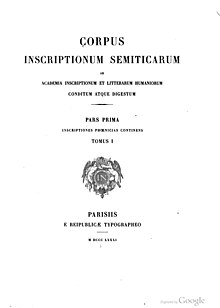Our website is made possible by displaying online advertisements to our visitors.
Please consider supporting us by disabling your ad blocker.
Corpus Inscriptionum Semiticarum

The Corpus Inscriptionum Semiticarum ("Corpus of Semitic Inscriptions", abbreviated CIS) is a collection of ancient inscriptions in Semitic languages produced since the end of 2nd millennium BC until the rise of Islam. It was published in Latin. In a note recovered after his death, Ernest Renan stated that: "Of all I have done, it is the Corpus I like the most."[1]
The first part was published in 1881, fourteen years after the beginning of the project. Renan justified the fourteen-year delay in the preface to the volume, pointing to the calamity of the Franco-Prussian war and the difficulties that arose in the printing the Phoenician characters, whose first engraving was proven incorrect in light of the inscriptions discovered subsequently.[2] A smaller collection – Répertoire d'Épigraphie Sémitique ("Repertory of Semitic Epigraphy", abbreviated RES) – was subsequently created to present the Semitic inscriptions without delay and in a deliberately concise way as they became known, and was published in French rather than Latin. The Répertoire was for the Corpus Inscriptionum Semiticarum what the Ephemeris epigraphica latina was for the Corpus Inscriptionum Latinarum.
The publication of the series continued until 1962.
- ^ Willemetz Geneviève, Sciences et techniques autour d'Ernest Renan. In: Études Renaniennes, N°84, 2e trimestre 1991. pp. 3-5: "De tout ce que j'ai fait, c'est le Corpus que j'aime le mieux"
- ^ Pars 1, Tomus 1, p.XI-XII: "Neque hos viros culpandos facilius credas quod inde ab anno 1867, inter opus decretum et inceptum, anni quatuordecim, grande mortalis ævi spatium, intercesserunt. Hoc enim temporis intervallo, quæ patriæ clades, qui civiles tumultus, quæ rerum novarum cæca exspectatio! Porro ea fuit operis hujus conditio, ut cultius auctiusque prodire magis oporteret quant festinantius in publicum emitti. Neque vero nos culpæ, si qua est, pœnitet, quandoquidem operi instituto mora plus boni quant detrimenti altulit..."
Previous Page Next Page


